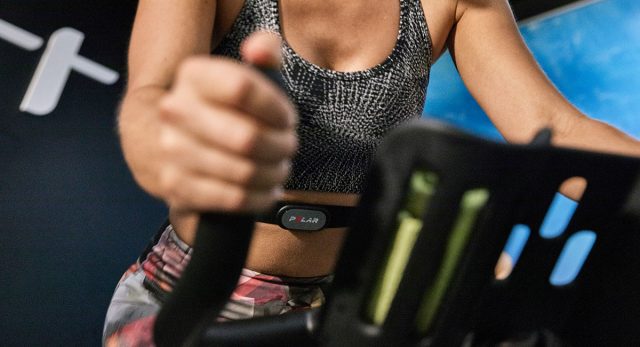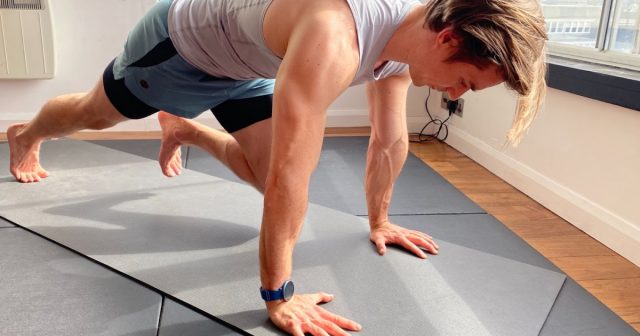If your goal is to lose weight, there are a handful of ways to make that happen. While adjusting your diet is key, adding exercise will help make your goals a reality.
But there’s a huge difference between a 20-minute walk-and-talk with your friends and a two-hour brick workout. Both can be effective – but how do you know what’s really getting you where you want to go?
If you’re wearing a heart rate monitor, it’ll be much easier to tell if you’re working out in the target heart rate for weight loss. Data doesn’t lie, so consider your monitor your best workout buddy (along with a great pair of sneakers).
Here are three things to keep in mind when you’re exercising to lose weight.
1. Don’t obsess over the “fat-burning zone.”
People and gym equipment alike love the term “fat-burning zone” because it makes everything seem so easy. Work out in that desired zone for a while and bam, you’re back in your high school era jeans! The reality, of course, isn’t quite so simple.
Heart rate can can guide your workouts to be more efficient, ultimately helping you burn more calories and lose weight.
“Heart rate can be a valuable indicator of how hard you’re working during exercise, but there are many other factors that can affect weight loss,” says NASM-certified personal trainer Anthony Baugh. “If used correctly, it can guide your workouts to be more efficient, ultimately helping you burn more calories and lose weight.” But, Baugh says, the fat-burning zone people talk about isn’t one size fits all.
Generally speaking, when you’re working out, you’re within one of five HR zones:
Zone 1
50 to 60 percent of your maximum heart rate. This is your warm-up, cool-down, and recovery zone.
Zone 2
60 to 70 percent of your max heart rate. This is an average effort that’s easy to maintain while holding a conversation. (Think a long, slow distance run.)
Zone 3
70 to 80 percent of your max heart rate. (Slightly easier than a tempo run, for example.)
Zone 4
80 to 90 percent of your maximum heart rate. This is a hard effort, but it’s sustainable. (Now you’re at tempo pace!)
Zone 5
90 to 100 percent of your heart rate. This is as hard as you can go.
Zones 1 and 2 are your main fat-burning zones.
Zones 1 and 2 are your main fat-burning zones. When you’re working out within these zones, most of the calories you’re burning are coming from fat. The higher your zone, the less fat and more sugars you’re burning.
When your goal is to lose weight, you want to burn fat – and many people assume that the harder you’re working, the more weight you’ll lose. But when you’re exercising at a lower intensity, your overall calorie burn will be lower than during a high-intensity workout, regardless of where those calories come from.
2. So the numbers matter…
It’s helpful to have a constant indicator of how hard you’re actually working, since some days a hard effort feels easy and other days a literal walk in the park feels like a marathon. But despite the allure of the so-called fat-burning zone, you’ll probably want to add at least a few high-intensity workouts to your weekly routine.
When you’re exercising at a low intensity, you may burn fat, but you stop burning anything as soon as you’re finished working out. But when you up the ante – say with a HIIT-style boot-camp class or interval run or ride – you create what’s known as the afterburn effect.
The afterburn effect is the metabolic disturbance that burns calories even after your workout is over.
The afterburn effect, also known as “EPOC” (that’s excess post-exercise oxygen consumption) is the metabolic disturbance that burns calories even after your workout is over. (So yes, you’re still burning calories when you’re back home on the couch on your third straight episode of Stranger Things.)
And in this case, science has your back. A University of Southern Maine study looked at the total calorie burn of low-intensity exercise vs. high-intensity exercise, and found that the difference in calorie burn was substantial. The low-intensity group that cycled at a steady rate burned 29 calories in 3.5 minutes, while a group running 15-second sprints only burned four calories.
But when it came to the afterburn, the cycling group only burned an additional 39 calories, while the runners burned 65. The cycling group worked out almost five times longer than the sprinters, and the sprinters burned 95 percent of their calories after the workout was complete.
Getting into the higher zones is probably more effective for weight loss.
So while sticking to Zones 1 and 2 can be enjoyable and the best way to enjoy a long, chatty run with friends, getting into the higher zones is probably more effective for weight loss.
“I’ve always found that the best way to drop fat and lose weight is actually to train in short, hard intervals that max out your heart rate,” says Baugh. “Lower-intensity intervals can be useful, but they’re generally less effective for weight loss.”
3. …but the numbers outside the gym matter more.
The “calories in, calories out” adage may be outdated – after all, a calorie from broccoli is pretty different when considering its overall nutritional value than a calorie from a Pop Tart – but calories and your diet are still the single most important factor when setting out to lose weight.
Calories and your diet are still the single most important factor when setting out to lose weight.
“It’s all about calories consumed and calories burned,” says Baugh. “Fortunately, using a heart rate monitor can help give you a more accurate gauge of just how many calories you’ve burned.” To lose weight, you have to burn more calories than you consume – so while yes, it’s science, it also comes down to simple math.
If you liked this post, don’t forget to share so that others can find it, too.
Or give it a thumbs up!
I like this article
Please note that the information provided in the Polar Blog articles cannot replace individual advice from health professionals. Please consult your physician before starting a new fitness program.





